AI Sovereignty in Australia & NZ: Why It Matters (and When It Doesn’t)
- Arkane Insights Team

- Oct 17
- 5 min read
Updated: Oct 24
What Is AI Sovereignty
AI sovereignty refers to a nation’s ability to develop, control, and deploy artificial intelligence systems without dependence on foreign powers or global technology providers. It is much broader than just LLM’s and includes domestic capability in algorithms, data infrastructure, and workforce.
Both the Australian and New Zealand governments recognises AI sovereignty as a key component of digital resilience. In Australia The National Robotics and AI Strategy (2024) highlights the importance of local compute capacity, skilled workforces, and transparent governance frameworks for critical AI systems.

The Four Layers of AI Sovereignty
National AI sovereignty is built across four interconnected layers, each essential to long-term capability.
Hardware and infrastructure – Chips, GPUs, and data centres form the computational foundation.
AI models – The full range of model types, from foundation and open-source models to domain-specific systems for language, vision, and decision-making, all operating on that infrastructure.
Skills and workforce – The broader human capability that enables AI, including technical experts, educators, and a digitally literate population. It also includes organisational readiness, leadership understanding, and a culture that supports responsible AI adoption across industries.
Applications – The layer where AI creates measurable business value.
A sovereign nation must show strength across all four. Australia & NZ has credible capability across some layers but dependence remains, especially in GPU supply chains and access to high-end foundation models. Organisations such as Sovereign AI Australia, Firmus, and ResetData are expanding domestic data-centre and compute capacity, but full self-sufficiency is still emerging.
From National Policy to Business Reality
At a national level, AI sovereignty is about reducing technological dependence and maintaining control over critical decision systems. Governments care because these systems influence defence, infrastructure, and public safety and our future national prosperity may depend on having our own AI capability.
At the business level, the term means something more practical: ensuring you maintain control over your data, models, and deployment environments even when leveraging third-party AI tools.
Most organisations can safely use overseas AI services such as OpenAI, Google Gemini, or Anthropic through public APIs. But for classified, regulated, or critical data, AI sovereignty in Australia and New Zealand becomes a requirement.
How AI Sovereignty Plays Out Across Different Organisations
The relevance of AI sovereignty depends on what kind of organisation you are and how AI supports your operations. The goal is to align your infrastructure and governance approach with the sensitivity of your data and your regulatory context.
1. Early-stage and product-focused organisations
Startups and scale-ups developing AI-enabled products should prioritise speed and iteration over infrastructure control. At this stage, using global AI platforms such as OpenAI or Anthropic is efficient and low risk. Revisit sovereignty once you achieve product-market fit or begin handling customer data.
2. Regulated industries and government contractors
Financial institutions, utilities, healthcare providers, and defence suppliers face compliance obligations under frameworks such as CPS 230 and CPS 234. For these sectors, sovereign or hybrid infrastructure hosted within Australia is rapidly becoming the standard expectation.
3. Technology and service providers
Software and SaaS vendors that process client data share the responsibility for sovereignty with their customers. Clear data-residency clauses, audit rights, and Australian hosting options are critical to maintaining trust and meeting enterprise procurement standards.
4. Other organisations
Professional services firms, manufacturers, logistics companies, and similar businesses often use AI for efficiency and insight rather than core decision-making. For these organisations, partial sovereignty is usually sufficient. They can rely on commercial AI services while applying contractual controls for any sensitive data.
Sovereignty Is a Spectrum, Not a Binary
As sovereignty has many layers it is a spectrum of control rather than a binary state.
Option | Description | Example Use Case |
Full self-hosting | Local infrastructure and locally trained models | Defence, national security |
Hybrid sovereignty | Foreign models on Australian cloud with data-residency guarantees | Financial services |
Open-source local models | Examples include Llama or Mistral running on Australian servers | Research institutions |
Contractual control | SaaS or public AI models with negotiated data clauses | Professional services |
Commercial cloud | Fully managed foreign AI services | Startups, non-sensitive workloads |
The Business Case: When Is Sovereignty Worth It
Building sovereign or hybrid AI capability is not just a technical decision. It is a question of business value, risk tolerance, and regulatory obligation.
Sovereign AI capability often costs more at the start. It requires investment in local hosting, governance, and skilled teams. The return comes when that control reduces compliance exposure, protects intellectual property, or improves customer trust.
Think about your organisation in practical terms:
Defence and critical infrastructure. Sovereignty is mandatory. You must maintain full control over systems and data.
Banks, insurers, and large utilities. The cost is justified for some use cases by the need to meet regulatory standards such as CPS 230 and CPS 234 and to reassure customers about data protection.
Professional and industrial firms. Consider sovereignty selectively. Use local infrastructure for sensitive data but global AI platforms for non-critical analysis.
Startups and SaaS providers. Focus first on speed and innovation. Adopt sovereign options only once your product or customer base requires it.
In most cases, a hybrid approach makes sense. Keep critical data and models within Australia while using global AI services for experimentation and lower-risk workloads. That balance gives you flexibility without unnecessary cost.
A Practical Decision Guide to AI Sovereignty
Before choosing AI infrastructure, classify the data your system touches.
Data Type | Example | Sovereignty Expectation |
Classified or PROTECTED data | Defence, national security | Must be hosted locally |
Personal or financial data | Banking, health, HR systems | Local preferred or strict contractual controls |
Proprietary or competitive data | Product designs, pricing models | Depends on risk tolerance |
Public or open data | News, weather, academic data | Minimal sovereignty concern |
The Bottom Line for AI Sovereignty
For businesses AI sovereignty should be a practical choice about control, cost, and confidence.
For governments, it represents national resilience and security.For businesses, it represents trust. Knowing where your data lives, who can access it, and how dependent you are on foreign technology.
Every organisation should understand its position on that spectrum. The goal is not to pursue sovereignty for its own sake, but to apply it where it genuinely reduces risk or strengthens your strategic position.
The most effective approach is usually incremental. Start by classifying the data your AI systems use, determine where sovereignty truly matters, and design governance and infrastructure that reflect that risk level.
Sovereignty done well protects value instead of slowing progress.
About Arkane Group
Arkane Group is an AI & Digital engineering and consulting firm helping Australian and New Zealand businesses develop practical AI capability and navigate digital transformation.
Our team combines technology strategy, hands-on implementation, and board-level advisory. We guide companies through their first AI pilot, scale existing initiatives, or architect enterprise-wide transformation programs. Delivering executive training, technical roadmaps, and implementation support that drives ROI.
Making business simpler with AI.
Visit us at https://www.arkanegroup.com




Comments